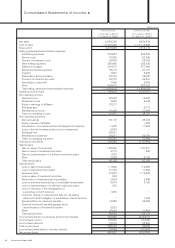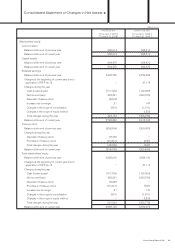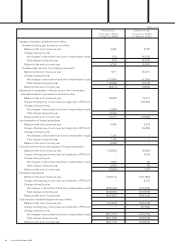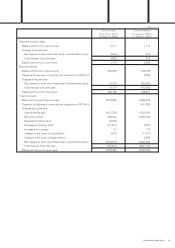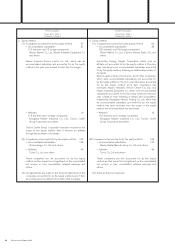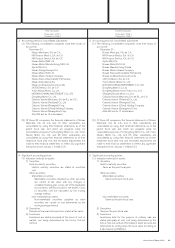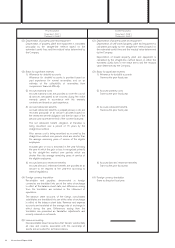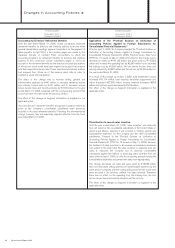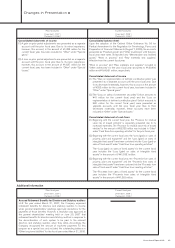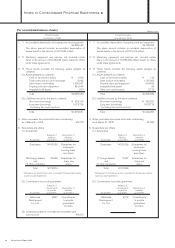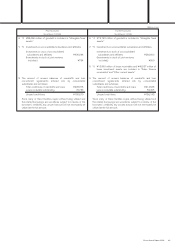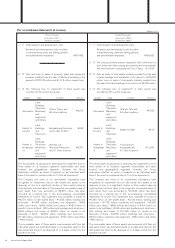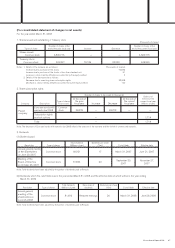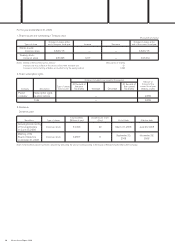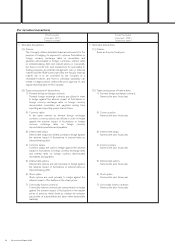Nissan 2009 Annual Report Download - page 44
Download and view the complete annual report
Please find page 44 of the 2009 Nissan annual report below. You can navigate through the pages in the report by either clicking on the pages listed below, or by using the keyword search tool below to find specific information within the annual report.
Changes in Accounting Policies >
42 Nissan Annual Report 2009
Prior fiscal year Current fiscal year
From April 1, 2007 From April 1, 2008
[
To March 31, 2008
][
To March 31, 2009
]
Accounting for Directors’ Retirement Benefits
Until the year ended March 31, 2008, certain subsidiaries expensed
retirement benefits for directors and statutory auditors to income when
general shareholders’ meetings approved resolutions for the payment of
those benefits. In April 2007, a new position paper was issued by the
Japanese Institute of Certified Public Accountants to clarify the
accounting treatment for retirement benefits for directors and statutory
auditors. In this connection, certain subsidiaries began to record an
accrual for the retirement benefits for the directors and statutory auditors
at the amount which would have been required to be paid in accordance
with their respective internal rules if those directors and statutory auditors
had resigned their offices as of the balance sheet date in order to
establish a sound financial position.
The effect of this change was to increase selling, general and
administrative expenses by ¥441 million, to decrease operating income
and ordinary income each by ¥441 million, and to decrease income
before income taxes and minority interests by ¥1,569 million for the year
ended March 31, 2008, compared with the corresponding amounts that
would have been recorded under the previous method.
The effect of this change on Segment Information is explained in the
applicable notes.
“Accrued directors’ retirement benefits” recognized on balance sheets by
some of the Company’s consolidated subsidiaries were previously
included in “Accrued retirement benefits.” Following the aforementioned
change, however, they are separately reported effective from the fiscal
year ended March 31, 2008.
Application of the “Practical Solution on Unification of
Accounting Policies Applied to Foreign Subsidiaries for
Consolidated Financial Statements”
Effective April 1, 2008, the Company adopted the “Practical Solution on
Unification of Accounting Policies Applied to Foreign Subsidiaries for
Consolidated Financial Statements” (ASBJ Practical Issues Task Force
(PITF) No. 18 issued on May 17, 2006). The effect of this change was to
decrease net sales by ¥160,145 million and gross profit by ¥147,683
million and increase the operating loss by ¥2,649 million but to decrease
the ordinary loss by ¥4,258 million, the loss before income taxes and
minority interests by ¥3,667 million and the net loss by ¥2,349 million for
the year ended March 31, 2009.
As a result of this change, as of April 1, 2008, total shareholders’ equity
increased ¥47,114 million, total valuation translation adjustments and
others decreased ¥87,892 million, minority interests decreased ¥898
million and total net assets decreased ¥41,676 million.
The effect of this change on Segment Information is explained in the
applicable notes.
Classification to record sales incentive
Until the year ended March 31, 2008, “sales incentive” was deducted
from net sales for the consolidated subsidiaries in the United States of
America and Mexico, whereas it was included in “Selling, general and
administrative expenses” for the Company and the other consolidated
subsidiaries. Pursuant to the “Practical Solution on Unification of
Accounting Policies Applied to Foreign Subsidiaries for Consolidated
Financial Statements” (PITF No. 18 issued on May 17, 2006), however,
the treatment of sales incentive for all overseas consolidated subsidiaries
was unified to the effect that the sales incentive is deducted from net
sales. In response, the Company and its domestic consolidated
subsidiaries applied the method of deducting sales incentive from net
sales, effective April 1, 2008, to unify the accounting principle among the
consolidated subsidiaries and present net sales more appropriately.
This change decreased net sales and gross profit by ¥15,938 million
each and decreased selling, general and administrative expenses by the
same amount compared with the corresponding amounts that would have
been recorded if the previous method had been followed. Therefore,
there was no effect on the operating loss, the ordinary loss, the loss
before income taxes and minority interests and the net loss.
The effect of this change on Segment Information is explained in the
applicable notes.


